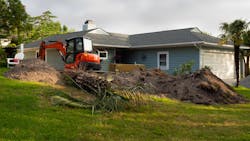The busiest place under the Earth: How runoff impacts soil
Sidewalks, parking lots, construction sites, building roofs are all typical sources of runoff that contribute pollutants and sediment to our water. But your lawn? In fact, yes, it just very well might be says soil expert Dr. Rattan Lal, distinguished university professor and director of the Rattan Lal Center for Carbon Management and Sequestration at The Ohio State University. Aside from managing runoff, he explains, the intricacies of soil management are essential to sustaining life itself. And topsoil is of special concern.
"Any time you disturb soil, and you interrupt the natural processes taking place in the first two inches of soil, the invitation to disruption of natural processes is wide open,” Dr. Lal said.
He describes topsoil as geoderma, literally, the skin of the earth with near amazing properties that most take for granted. As a soil specialist, Lal cites topsoil as playing a crucial role in multiple environmental activities.
"The topsoil has a continuous interaction with plant roots that have been established in that material,” he said. “And these roots and the vegetation residue gives it humus content, organic content, and as 25% of all living organisms live in topsoil, it is an amazing living entity. What we take for granted as a shovel full of dirt is chock full activity, indeed one of the most active places under the surface.”
He said that this material topsoil is a living entity, and it has the capability to take any dead matter, decompose it, and in doing so take the carbon dioxide, plant and animal remains, and convert those nutrients into the nutrients that become part of another lifecycle.
"This is really the only place in the universe that turns death into life,” he said.
However, if this were universally acknowledged, humans would likely be doing a better job of taking care of this asset that Lal says is “the gift of Mother Earth.”
He further describes how the value in soils and their ability to maintain the cycle of life are also a source of untapped medical wealth.
"In one teaspoonful of healthy soil that has not been disturbed, we will find a million or more microorganisms that are the source of 90% of all the antibiotics we've developed,” he said. “I had a meeting more than a decade ago with medical doctors who asked what we could do to keep soil undisturbed and how we could retain this mine of resources that can do good for plants, animals and people. It is a commentary on our perception of soil that we treat it with such little value whereas we all want clean air to breathe, and clean water to drink. Soil might be said to be as much, if not more necessary, as where else can you grow food?”
In 2005, Lal and other advocates took the case for a soil protection policy to U.S. Congress emphasizing the need for soil policy to be on equal footing with the Clean Water and Air acts. Supported by compelling scientific evidence, the group presented the argument that U.S. soils deserve the same rigorous protection.
"We actually did have what was then known as Senate Resolution 440 passed, but it was never made into an act,” he said. “And you have to have an act in order to have appropriations that pay for regulatory process and then provide for oversight and compliance to ensure the protections you want are being met."
Without a Healthy Soils Act, he says there is little incentive for changes in protocol during any ground disturbance, such as construction, agriculture and other industries who move or interact with soil on a regular basis. Lal illustrates that healthy soils are not only the foundation for managing optimal life cycles, but they are also essential to best practices mitigating runoff, erosion and other outcomes where there is no sustainable root mass.
"People who question me, like farmers for example, who may see a healthy soils act as another controlling measure ask why we need this,” he said. “But I tell them my philosophy on preserving as much integrity to our soils as possible is one of good management.”
He said the more people who voluntarily do this good management set an example and then others will follow.
"Ultimately, the reward to those who worked without the enforcing bodies at their heels are rewarded by seeing that regulations will follow, which will then have everyone all playing to the same music,” Lal said. This is just how human nature works."
Treat, save and stockpile with care
At Rocky Mountain Bio Products, Division President/Technical Sales Tom Bowman said he began the company as an outgrowth of his Colorado-based company, Bowman Construction Supply Inc., and it was the perfect marriage 'from the ground up.'
"Our construction supply side serves customers the moment anyone moves dirt,” he said. “
“They need what we supply, whether its waterproofing [or] architectural supplies. We provide materials for revegetation/reclamation, new seeding and reseeding for landscaping to mine reclamation; ,rom organic fertilizer, soil conditioners and amendments, plus biotic soil amendments– basically finishing out your project to best advantage."
He says the one disturbing thing they see is, "In construction, people look at dirt and don't see it in its many classifications – soil, dirt, overburden, bedrock, all the layers in the soil profile. They bring in a grader or a dozer, grade the top off and then start digging. They're literally pushing away gold, and this is a real problem."
Bowman says some mining companies do try to save the topsoil and then reintroduce it, but even those techniques require careful handling.
"If you're going to salvage your topsoil and stockpile it, what you need to do is put it in short wide windows,” he said. “Then plant a cover on it like a rye annual or something to help the soil microbes remain alive and active."
He explains there are several reasons to do this aside from preventing it blow away.
"First, when you disturb topsoil, you are taking away its natural habitat of micronutrients and the root systems that thrive in those are suddenly gone,” Bowman said. “So, you want to reintroduce a plant that will be a food source, and this will pay off later when you re-spread it."
"Plus, what happens to all the microbial life if it is piled ten feet deep? When it's deprived of oxygen, water and a food source it just becomes dead. Then, when you go to use it the soil can't support your new seeds so you have to add in fertilizer and nutrients to replace what is now missing."
Bowman also said when soil is deprived of oxygen, water and a food source, it dies, meaning it cannot support new seeds. He also added that the best erosion and runoff control is a healthy and dense root mass that helps the soil microbes remain alive and active.
He emphasizes the effects of improper topsoil management.
"When you disturb the top 7-9 inches of soil, you destroy 90% of the microbial life,” he said. “We are constantly disturbing and then having to refurbish soil to build it back up, and in the meantime, without the thick root mass, we see water not being absorbed and a new lawn can potentially be a source of runoff in the same manner as a parking lot."
Bowman’s experience and encounters with these dilemmas during the construction work became the premise for his work with Rocky Mountain Bio Products. The work was designed to supply superior amendments that give disturbed soils a best chance of recovery to support soil and plant life.
"A lot of people are selling amendments, but you have to understand just because it's brown and looks good doesn't mean it can do the job you need done,” Bowman said.
The compost challenge
One culprit he targets is uncured compost that creates a phenomenon not many consider.
"When you add compost, you have to make sure it has finished curing,” he said. “It's a great source of organic material, it doesn't fix everything immediately. We see a lot of projects where they get good growth for a year adding compost and fertilizer. But then, as time goes on, and because the compost is not yet done curing, all the additives dissipate and then the woody debris is all that's left, and it is sucking out nutrients from the plants to cure.”
He continued, "So, the result of your good intentions via compost and mulching can backfire with a failing lawn or garden, and then you are baffled because you're sure you did all the right things, except have properly cured mulch."
In developing his soil amendments, Bowman says it a full and nutritionally complete diet for establishing great plant sustainability. Each of the company’s four product line-ups, including Biosol Forte, and Earthgreen’s Menefee Humate, MycoApply Mycorrhizae and PermaMatrix – BSA (Biotic Soil Amendment), contain all organic additives they manufacture from a scientifically created proprietary formula.
These include microbiota, fungal biomass and bacterial biomass that are developed through a natural fermentation process which is then sterilized and ensured to be free of weed seeds.
"Typically, we recommend one product application for restoration/reclamation and only twice a year for the first couple of years for landscaping and then maybe just once a year as they are designed as slow-release products,” he said.
Bowman said he encourages municipalities to look closely at how construction projects will introduce plants once their part is done. He says soil is like people, it is not a one-size fits all endeavor, "and what you can do in Minnesota you can't do in Mississippi, nor should you.”
"Putting good organic matter back on to develop a root mass as quickly as possible is ideal, and we encourage they plant native plants whenever possible,” he said. “These are more environmentally friendly, and they can sustain droughts, heavy rains, or cold weather, whatever unique climate they are native and adaptive to. You want this distinctive resilience. Plus, their root mass will be deeper, and this is the best form of run-off prevention and erosion control you could want. You want a superior underground root mass to hold these soils in place."
And he cites there is another reason municipalities should promote natives.
"Just ask your water treatment people, they will be your best supporters," he says.
Bowman said that a lot of organic rhizomes will take out pollutants, heavy metals and contaminants that are coming from surfaces of a site.
“Plants are nature’s perfect water treatment plant, and native plants can grow for multiple years, re-seeding themselves,” he said. “And if you think about it, they keep down weeds. When you go out in the native grasslands you don't see a lot of weeds because the native ones control that space, and they don't require fertilizer."
Anyone who has tried to keep African Violets and orchids or other exotics in their dining room knows just how heroic the efforts must be made to replicate a native environment.
Finally, Bowman said you can train plants to be weaned off nutrients and encourage their roots to dive deeper in the soil to search for food. He says their Rocky Mountain slow-release organic formula promotes that root system to search further, and in doing so, it needs less water and "you can go without irrigating and be confident your plants are going to thrive just fine."
In the end, preserving soil is the responsibility of everyone to protect and preserve.
"Educating the building construction industry, plus homeowners and property owners to become more sensitive to their soil management by using appropriate plants and additives benefits the properties, the water supply and is a conservation goal we should all adopt.
"There's a whole world of life under our feet and we need to protect preserve it,” Bowman said.


